Fake Out
| |
To
Use or Not to Use |
|
| |
Faking
is an effective sparring strategy, but that does not mean you should use it all
the time. If you are more experienced, faster and stronger than your opponent,
you can probably succeed with a decisive and direct attack. But if his skill
level is close to yours, you may want to fake to create an opening.—DJN
Timing Is
Everything
To be effective, a fake must be done in one-half the time it takes to do a
regular strike. Known as “moving on the half count, ”it enables you to disrupt
your opponent’s rhythm. However, if you create too great a time gap between
your fake and your real strike, it could be blocked or countered.
—DJN |
|
6 Sparring Strategies
Offer The Ultimate In Deception
from the August, 2001 issue of
Black Belt Magazine
| |
Click Image
for Next |
|
| |
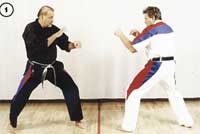 |
|
| Indirect angular attack: Dennis
Nackord (left) and Joe Lewis square off (1). Nackord uses a hip fake to force
Lewis to lower his guard (2), then delivers a back-hand strike to the head. |
| |
Click Image
for Next |
|
| |
 |
|
| Broken-rhythm attack: Joe Lewis
(right) and Dennis Nackord prepare to attack (1). Nackord moves into Lewis’
range to elicit his counter kick (2). Nackord fades away as the kick is
delivered (3), then follows up with a reverse punch (4).
|
| |
Click Image
for Next |
|
| |
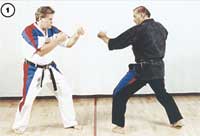 |
|
| Immobilization attack: Joe Lewis
(left) readies himself to go on the offensive (1). He grabs the opponent’s arm
to prevent him from retreating (2), then obstructs his lead leg to break his
balance (3). Lewis finishes with a reverse punch to the head (4). |
| |
Click Image
for Next |
|
| |
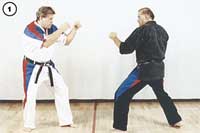 |
|
| Redirect attack: Joe Lewis (left)
prepares to set up opponent Dennis Nackord (1). Lewis then opens his centerline
to draw an attack (2). When the opponent punches, Lewis redirects his arm (3)
and shoots in a counter kick (4). |
| |
Click Image
for Next |
|
| |
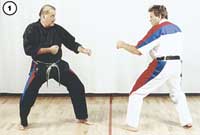 |
|
| Indirect-angular/broken-rhythm
combination: Dennis Nackord (left) faces his opponent (1). He fakes to his left
with an inverted punch to draw the opponent’s counter kick (2). As the kick is
executed, Nackord does a stagger step to the right (3) and unleashes a punch to
the body (4). |
| |
Click Image
for Next |
|
| |
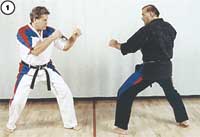 |
|
| Combination angular attack: Joe
Lewis (left) and Dennis Nackord square off (1). Lewis fakes high, causing the
opponent to react (2). Lewis then grabs the opponent’s lead arm and chambers
his leg (3). He sends a side kick into Nackord’s ribs (4) and finishes with a
punch to the head(5). |
The best martial artists know the
value of strategy. They know that sometimes throwing their best technique
simply does not get the job done. They know that in times like those,
strategies that utilize effective set-up, delivery and timing can be more
important than execution. They also know that one of the most efficient
strategies is the fakeout.
The six faking strategies described in this article will serve you well whether
you employ them in the ring or on the street. I can say that with confidence
because they have been tested over the past four decades by Joe Lewis, my
instructor and training partner since 1967, and me.
We started using them prior to and during the reign of our West Coast National
Fighting Team in the late 1960s and early 70s, and we have used and taught them
ever since. I certainly did not invent the strategies, but I have cataloged
them into what I believe is a useable format.
The six strategies have built many fighters’ self-confidence and
propelled them to national and world titles. They are so universally valid that
they can be used in any sport, competition or armed conflict. For the purpose
of this article, however, they will be discussed in relation to empty-hand
sparring.
In sparring, deception refers to the ability to fake out your opponent and is
often an essential factor in defeating. However, determining and implementing
the correct deceptive strategy for the particular opponent you are facing can
be a challenge. The key to success involves “probing.”
Each opponent you face has a tendency to act a certain way. He has favorite
moves that make up his personal style of fighting. Some opponents charge in,
some stay back, some like to kick, some like to punch and some like to use
other approaches. Probing teaches you to use false leads to figure out your
opponent’s preference. (False lead refers to extending a weapon toward your
opponent without committing your body weight.) When you step into the ring with
a new opponent, probe to see what he does, then choose a strategy that fits his
style.
Three
elements
Before embarking upon an in-depth discussion of faking strategies, it is
essential to review the role of perception. Does your opponent believe what
he’s seeing is really happening? If he does, he will always react. Some
opponents react correctly to minimize their vulnerability, but most make some
type of mistake when reacting.
For a fake to be believable, three elements must be used correctly. The first
is distance. You must be close enough to your opponent to actually hit him if
your fake were a strike. A common mistake involves throwing a fake from too far
away. For it to work, it must be executed from a realistic distance. The second
element is angle. To threaten your opponent, a fake must travel along the same
line as an actual attack. Another common mistake students make is to simply
throw their hand in the air or stomp their foot on the mat. Since the fake is
not angled toward any target, it usually elicits no reaction from the opponent.
For it to work, it must travel along a realistic angle.
The third element is intensity. A fake must have realistic speed, intent and
emotional substance. You must throw it as if you are actually trying to hit
your opponent. Fighters frequently make the mistake of throwing a passive fake
followed by an aggressive strike. If the opponent does not react to the fake,
they are left vulnerable. For it to work, it must include the use of realistic
intensity.
Strategies
for Lead Fighters
At any given moment during a sparring match, you fall into one of two
categories: lead fighter or counter fighter. Of course, you can switch from one
style to the other or even merge them, but for the purposes of this article,
they will be considered separately. When you are a lead fighter, you should not
attack a strong position. You should first weaken your opponent’s position with
a fake or deceptive action to make him pause. That will create an opening, and
the hesitation can enable you to score. Remember that when you attack, you must
make your opponent hesitate.
Indirect Angular Attack
This strategy is used against a person who stands his ground and blocks. It
involves a fake of angle.
Example: Move into the range of your opponent with allow fake (on the half
count—see sidebar) and follow with a high strike. This sequence can be reversed
with a high fake and a low strike. These two combinations are among the most
common indirect angular attacks.
Broken-Rhythm Attack
This strategy is used against a person who is a counterfighter. That is,
whenever you attack, he tries to counterattack. You need to draw his counter,
then hit him while his weapon is returning from the missed counter. Example:
You have determined that your opponent will try to counter punch. Therefore,
you move into his range to draw his punch and move out of range when he
delivers it. This action causes him to miss and allows you to score when he is
out of position.
Immobilization Attack
This strategy is used against a runner or a person who doesn’t stand
still. This is the most sophisticated of the three lead-fighter strategies.
There are many ways to stop a person from moving away from you. One is to
reverse your direction and move away from him, thus drawing him toward you. Or
you can immobilize him by grabbing him or obstructing his leg with a check or
sweep. To be successful, immobilization attacks must include distance, angle
and attitude. Example: Lunge toward your opponent, grab his sleeve or arm and
pull him off-balance. Counter punch his body.
Strategies
for Counter Fighters
When you are a counter fighter, you want your opponent to attack you. By making
a certain part of your body seem vulnerable, you encourage him to attack that
area. Sometimes called baiting, this approach can weaken his position by
allowing you to know where he will attack. A skilled counter fighter has the
ability to cause his opponent to use a specific weapon at a specific time to a
specific target. Remember that when you are attacked, you must make your
opponent miss.
Redirect Attack
This strategy focuses on redirecting your opponent’s energy. You can
accomplish that by moving his weapon off the line of attack using a parry or by
moving yourself off the line of attack using a slip. Most of the time, a
combination of these two tactics is used. Example: You lure your opponent into
throwing a fore-hand strike at your head, then slip it by moving off-line and
counter to his body.
Interrupt Attack
This attack interrupts your opponent’s energy by putting a greater amount
of energy in direct opposition to it using a stop-hit. Example: The attacker
uses a lunging punch delivered with his rear hand. As he crosses sides and
enters, you execute a defensive back kick to stop his forward movement. You
have moved into the line of attack.
Absorb Attack
This strategy revolves around absorbing your opponent’s energy. You can
do that by employing what is called a “target fade, ” which refers to using a
non-vital part of your body as a shield. Example: Your opponent throws a kick
at your body. You fade away from the attack just far enough so the kick touches
your shielding arm. You then counter with a spinning back-hand strike. You have
moved away along the line of attack.
Application
The six fighting strategies described above are tools you can use to conquer
any skilled opponent. Because they enable you to make successful choices while
facing a variety of fighters, they will also build your self-confidence in and
out of the dojo.
| Dennis J. Nackord
About the author: Dennis J. Nackord has a
ninth-degree black belt in kenpo. For seminar information, write to Nackord
Karate System, Gateway Shopping Center, 125 E. Swedesford Road,
Wayne, Pennsylvania
19087. Or call (610) 341-9900 or visit
http://www.nackordkarate.com |
|





